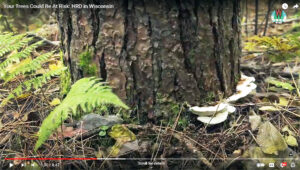
A Wisconsin Department of Natural Resources video on Heterobasidion root disease shows ways to identify the disease and presents best management practices. / Photo Credit: Wisconsin DNR
By Art Kabelowsky, DNR Forest Health Communications/Outreach, Fitchburg;
Arthur.Kabelowsky@wisconsin.gov or 608-335-0167
Now is an excellent time to look for symptoms of Heterobasidion root disease (HRD), a fungal disease that attacks and kills pine and spruce trees. The disease is present in 30 of Wisconsin’s 72 counties.
The Wisconsin Department of Natural Resources has produced a video, a fact sheet and a booklet of silvicultural guidelines to manage the disease. The video and other links are on the DNR’s Forest Health webpage for HRD.
The disease, formerly known as annosum root rot, manifests by showing fruit bodies (called conks) on the base of declining or dead trees and stumps. Young fruit bodies look like popcorn; as they age, they become bracket- or shelf-shaped. The conks are commonly seen in the fall but can be found at any time of the year.
The fungal spores, carried on the wind, colonize untreated stumps and spread to living trees via root contact. Symptoms progress over several years and result in tree mortality. Symptoms typically occur three to eight years after a thinning. HRD is challenging to control once in a stand, so prevention is the best approach.
Those who plan to thin out a stand to manage HRD are urged to consider treating freshly cut stumps with a pesticide such as Cellu-Treat or Rotstop®C as soon as possible after cutting (no longer than 24 hours).
The video and fact sheet carry more detailed information on the biology of HRD and best management practices.
